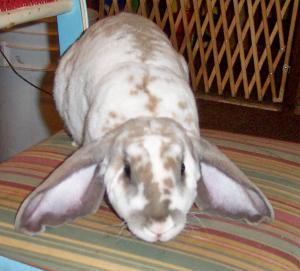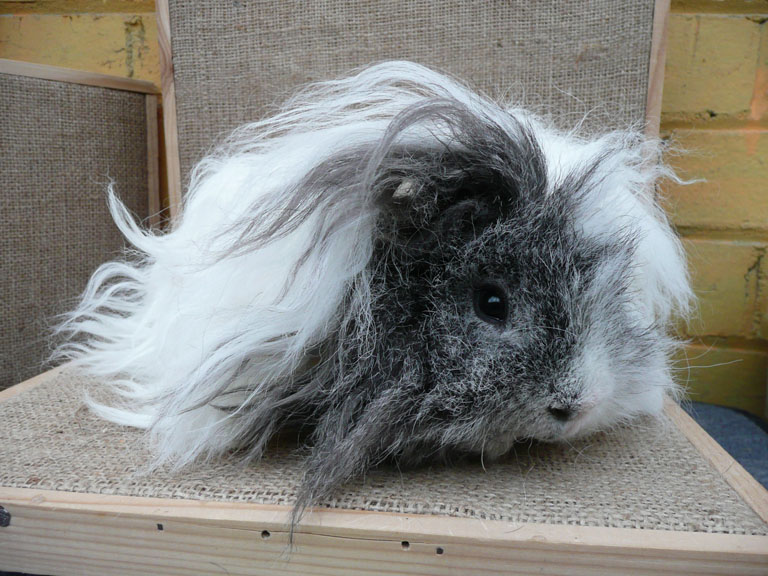|
The
VELVETEEN LOP STANDARD
Varities -
Agouti - Pointed White - Self - Shaded - Ticked - Wide Band
TO BE ENTERED AND SHOWN IN TWO CLASSIFICATIONS: Broken Pattern and Solid
Pattern
SCHEDULE
OF POINTS:
General Type
..........................................................................71
Body .........................................................35
Head .........................................................10
Feet, Legs & Bone .......................................5
Ears ..........................................................21
Length, width position
.................7
Substance and Shape ................ 7
Texture and Condition ................. 7
Fur
..........................................................................................
20
Color and Markings
..................................................................... 4
Condition
...................................................................................
5
TOTAL POINTS
............................................................................................100
SHOWROOM
CLASSES AND WEIGHTS
Senior Bucks & Does - 6 months of age and over 5 - 6-1/2 pounds (5-3/4
pounds ideal)
Junior Bucks and Does - under 6 months of age 3-1/2 pounds minimum - 6 pounds
maximum
Note:
Junior exceeding maximum junior weight may be shown in higher age
classification.
No animal may be shown in lower age classification than it's true age.
Note:
Overall balance and quality should be deciding factors in assessing merit and
worth.
Assessing exclusively on the unique ears should be avoided.
Measurement of the ears on the Velveteen Lop is to be taken from the tip of one
ear to the tip of the other ear.
A yardstick is strongly recommended for the most accurate measurement, and
should be set just behind the base of the ears,
resting on the neck. Ears are to be stretched to their greatest span. Do not
fold the ears.
Measurement of the width should be taken in several different places across the
back side of the ear to determine the widest point.
GENERAL
TYPE
BODY
- Points 35: In profile, the Velveteen Lop
should present the mandolin shape. The body top line should present a definite
arch, starting at the back of the shoulders and reaching its highest point over
the center of the hips, and gracefully sweep, rounded and full, to the base of
the tail. When viewed from above, the sides should taper slightly from the
hindquarters to the shoulders. The body is to have a well developed hindquarter,
midsection, and shoulder.Chest is to be full and rounded. Dewlaps are
permissible.
The Velveteen
Lop is a semi-arched breed and should be posed with the foreleg and hocks flat
on the table.
Faults -
Lack of arch, chopped; cut off hindquarters; narrow shoulders; pinched or
undercut hips.
Disqualifications from Competition - Pigeon breast; Deviated sternum;
short coupled, compact type.
HEAD
- Points 10: Head is to be a wedge shape in appearance - wide to
moderately full cheeks and tapering to a wide muzzle. Skull is to medium length,
with a curvature when viewed in profile. Neck is to be short.
Faults -
Hollow checks; pinched or snipey muzzle.
Disqualification from Competition - Any similarity to a Netherland Dwarf
head.
EARS -
Points 21:
Length, width and position - 7 points: Ears are to be carried low on the
head with no noticeable crown. Ears should hang loose and close to the body,
with ear opening to the front and not turned towards the head. Length to minimum
14 inches tip to tip.
Width of the ears should be approximately 1/4 of the total length of the ear.
Length of the ear is to balance with the body.
Substance
and shape - Points 7: Ears are to be uniformly thick enough not to be easily
blemished or torn, yet thin enough to maintain the longitudinal crease in the
ears. Ears are to be well rounded and wide at the tips.
Texture
and condition - Points 7: Ears are to be very soft, smooth and pliable. They
are to be free from tears, pimples an blemishes.
Faults -
Cut severely for the appearance of any crown or for ear openings turning to the
head.
Ears should not be pointed or trowel shaped.
Disqualification from Competition - Ears less than 14 inches in length.
Tears, holes, and blemishes which noticeably detract from the appearance of the
animal.
FEET, LEGS
& BONE - Points 5: Legs are to be medium boned, short to medium in
length, straight and parallel to the body - with good width between the hocks.
Toenails on the broken pattern may be either light or dark. Difference in
pigmentation between the front and rear toenails is permitted.
Faults -
Weak ankles; unmatched toenails on broken pattern.
Disqualification from Competition - Extremely long, fine bone. General
toenail disqualifications apply to all groups except brokens
FUR
- Points 20. The fur is to be dense, straight and upright, with a 5/8
inch ideal length. It is to be the same length and texture over the entire body.
The guard hairs, which are not to be noticeably protruding, are to be very
plentiful and evenly distributed. The fur is to have a lustrous appearance, good
body, and a plush like effect, which offers a distinct springy resistence to the
touch. The fur is to feel extremely smooth to the touch, but it is not to have a
soft, silky texture which would destroy the springiness of the fur's body.
Faults -
Fur that is dull, lacking luster, or density. Noticeably protruding guard hairs,
harsh; wiry, soft or silk textured fur;
wavy or uneven fur; fur which lacks guard hairs and thus lies flat when stroked.
Disqualification from Competition - Average fur length that is less than 3/8
inch or more than 7/8 inch.
COLOR
OR MARKINGS - Points 4 : All colors should conform to one of the
recognized Lop Color Guide descriptions. Points on broken pattern animals are to
be divided equally between color and markings. There should be a nose marking
(butterfly preferred), a dark circle of color around each eye, and solid colored
ears. Blanket body pattern is preferred. The color line should start behind the
head, on the shoulders, and make a sweep to the lower part of the hips. Feet and
legs should be white, with the exception of elbow spots, which are normal and
desirable. Eyes - color to conform to the Lop Color Guide descriptions.
Faults:
body and head patterns not conforming with the general descriptions.
Disqualification from Competition - Complete absence of any head
marking(s) on broken pattern animals. Brokens with less than 10% coloration.
Condition
- Points 5: Per ARBA definition. | 
